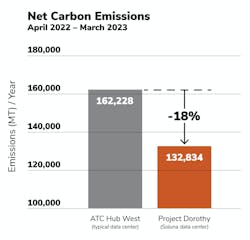REsurety report finds Soluna’s Project Dorothy has an 18% lower carbon footprint than traditional data centers
An independent study conducted by REsurety has found that Soluna’s Project Dorothy data center in Texas, used for bitcoin mining and other computing purposes, produces 18% less carbon emissions than traditional data centers and is up to 40% greener than other cryptocurrency mining centers.
REsurety used its Local Marginal Emissions data and analysis to conduct the study and compared the Soluna facility to other traditional around-the-clock data centers located in West Texas.
According to a whitepaper about the study written by Nicola Phillips and released by Solunas in collaboration with REsurety, Project Dorothy is a 50 MW data center co-located with a wind farm located in the Electric Reliability Council of Texas (ERCOT) West territory and is powered by three types of energy:
- Curtailed or stranded energy, which is energy that, if not used by the facility, would not make it back to the grid or, because of lack of demand, would have to be sold back to the operator at a deficit. This energy, because it is pulled from the wind farm, is 100% clean and has zero emissions impact.
- Subtractive energy, which is energy from the wind farm that would otherwise be sold but is instead purchased by Soluna. This energy is also 100% clean, but because it is not adding additional renewable capacity to the grid, it is factored differently.
- Grid energy, which is a last resort option reserved for when the other two types of energy are not available. Soluna data centers only consume this type of energy — a mix of clean and fossil fuel energy — when nodal or hub prices are below a specific threshold.
The data center’s total load is then determined by adding the amounts of subtractive, curtailed, and grid energy used. The whitepaper reports that fossil fuels make up 61% of power for the Texas grid, whereas Soluna data centers are, on average, powered by 75% clean energy.
This report also shows that Soluna’s emissions performance is superior to the average cryptocurrency mining data center. A WattTime report published in the New York Times found an average MW in their sample set induced emissions of 4,188 marginal CO2 tons per year. A similar methodological approach applied to the Project Dorothy data center revealed estimated emissions of 2,657 CO2 tons per year, almost 40% less.
In a press release, John Belizaire, CEO of Soluna Holdings, said, “Our journey began with a commitment to revolutionize data centers, focusing on minimal carbon impact and high efficiency. This independent study confirms our success in co-locating with renewable energy sites to establish a new benchmark in data center operations, especially crucial as we see a growing demand for sustainable cryptocurrency mining and AI computing resources.”
For related articles, visit the Business Topic Center.
For more information on high-speed transmission systems and suppliers, visit the Lightwave Buyer’s Guide.
To stay abreast of fiber network deployments, subscribe to Lightwave’s Service Providers and Datacom/Data Center newsletters.

Hayden Beeson
Hayden Beeson is a writer and editor with over seven years of experience in a variety of industries. Prior to joining Lightwave and Broadband Technology Report, he was the associate editor of Architectural SSL and LEDs Magazine.

